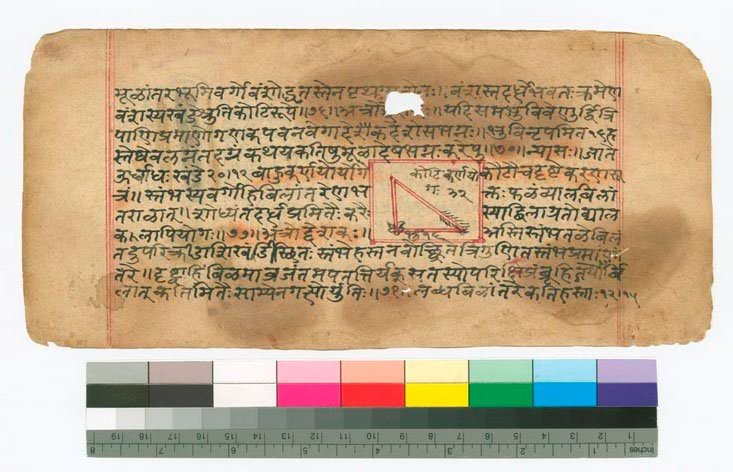- About MAA
- Membership
- MAA Publications
- Periodicals
- Blogs
- MAA Book Series
- MAA Press (an imprint of the AMS)
- MAA Notes
- MAA Reviews
- Mathematical Communication
- Information for Libraries
- Author Resources
- Advertise with MAA
- Meetings
- Competitions
- Programs
- Communities
- MAA Sections
- SIGMAA
- MAA Connect
- Students
- MAA Awards
- Awards Booklets
- Writing Awards
- Teaching Awards
- Service Awards
- Research Awards
- Lecture Awards
- Putnam Competition Individual and Team Winners
- D. E. Shaw Group AMC 8 Awards & Certificates
- Maryam Mirzakhani AMC 10 A Awards & Certificates
- Two Sigma AMC 10 B Awards & Certificates
- Jane Street AMC 12 A Awards & Certificates
- Akamai AMC 12 B Awards & Certificates
- High School Teachers
- News
You are here
Mathematical Treasures - Lilavati of Bhaskara

This is a page from a manuscript of the Lilavati of Bhaskara II (1114-1185). This manuscript dates from 1650. The rule for the problem illustrated here is in verse 151, while the problem itself is in verse 152:
151: The square of the pillar is divided by the distance between the snake and its hole; the result is subtracted from the distance between the snake and its hole. The place of meeting of the snake and the peacock is separated from the hole by a number of hastas equal to half that difference.
152: There is a hole at the foot of a pillar nine hastas high, and a pet peacock standing on top of it. Seeing a snake returning to the hole at a distance from the pillar equal to three times its height, the peacock descends upon it slantwise. Say quickly, at how many hastas from the hole does the meeting of their two paths occur? (It is assumed here that the speed of the peacock and the snake are equal.)
These verses and much else from the Lilavati may be found in Kim Plofker, "Mathematics in India", in Victor Katz, ed., The Mathematics of Egypt, Mesopotamia, China, India, and Islam: A Sourcebook (Princeton: Princeton University Press, 2007), pp. 385-514.

This page from the Lilavati gives another illustration of the Pythagorean Theorem.
Frank J. Swetz and Victor J. Katz, "Mathematical Treasures - Lilavati of Bhaskara," Convergence (January 2011)




